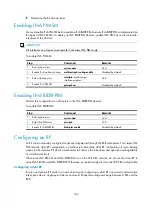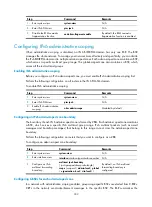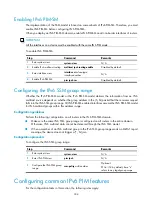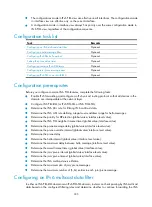
323
Configuring C-BSRs for IPv6 admin-scoped zones
In a network with IPv6 administrative scoping enabled, BSRs are elected from C-BSRs specific to different
Scope field values. C-RPs in the network send advertisement messages to the specific BSR. The BSR
summarizes the advertisement messages to form an RP-set and advertises it to all routers in the specific
admin-scoped zone. All the routers use the same hash algorithm to get the RP address corresponding to
the specific IPv6 multicast group.
The following rules apply to the hash mask length and C-BSR priority:
•
You can configure these parameters globally and for an IPv6 admin-scoped zone.
•
The values of these parameters configured for an IPv6 admin-scoped zone have preference over the
global values.
•
If you do not configure these parameters for an IPv6 admin-scoped zone, the corresponding global
values are used.
For configuration of global C-BSR parameters, see "
Configuring C-BSR parameters globally
Perform the following configuration on the routers that you want to configure as C-BSRs in IPv6
admin-scoped zones.
To configure a C-BSR for an IPv6 admin-scoped zone:
Step Command
Remarks
1.
Enter system view.
system-view
N/A
2.
Enter IPv6 PIM view.
pim ipv6
N/A
3.
Configure a C-BSR for an IPv6
admin-scoped zone.
c-bsr
scope
{
scope-id
|
admin-local
|
global
|
organization-local
|
site-local
}
[
hash-length
hash-length
|
priority
priority
] *
No C-BSRs are configured for an
IPv6 admin-scoped zone by
default.
Configuring IPv6 multicast source registration
Within an IPv6 PIM-SM domain, the source-side DR sends register messages to the RP, and these register
messages have different IPv6 multicast source or IPv6 multicast group addresses. You can configure a
filtering rule to filter register messages so that the RP can serve specific IPv6 multicast groups. If the
filtering rule denies an (S, G) entry, or if the filtering rule does not define an action for this entry, the RP
will send a register-stop message to the DR to stop the registration process for the IPv6 multicast data.
In view of information integrity of register messages in the transmission process, you can configure the
device to calculate the checksum based on the entire register messages. However, to reduce the
workload of encapsulating data in register messages and for the sake of interoperability, do not use this
checksum calculation method.
When receivers stop receiving data addressed to a certain IPv6 multicast group through the RP (that is,
the RP stops serving the receivers of that IPv6 multicast group), or when the RP starts receiving IPv6
multicast data from the IPv6 multicast source along the SPT, the RP sends a register-stop message to the
source-side DR. After receiving this message, the DR stops sending register messages encapsulated with
IPv6 multicast data and starts a register-stop timer. Before the register-stop timer expires, the DR sends a
null register message (a register message without multicast data) to the RP. If the DR receives a
register-stop message during the register probe time, it will reset its register-stop timer. Otherwise, the DR
starts sending register messages with encapsulated data again when the register-stop timer expires.
















































